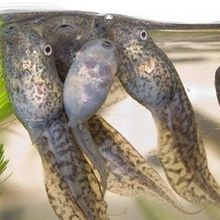Xenopus laevis

How Immature Egg Cells in Ovaries Resist Aging
Shafaq Zia | Aug 4, 2022 | 3 min read
The cells’ mitochondria skip a key metabolic reaction that takes place in other cells in the body, a study finds.

Scientists Use Photosynthesis to Power an Animal’s Brain
Abby Olena, PhD | Oct 13, 2021 | 3 min read
Injecting oxygen-generating algae into tadpoles allows brain activity to continue in the absence of oxygen, researchers find.

Image of the Day: Xenopus Pigment
The Scientist Staff | May 18, 2018 | 1 min read
Researchers recently used CRISPR single-guide RNAs to alter genes involved in pigmentation in frog embryos.

Tadpoles Keep Eating Because They Don’t Feel Full
Catherine Offord | Mar 27, 2018 | 1 min read
Baby frogs don’t develop the neural circuitry responsible for feeding inhibition until they begin metamorphosing into adults.

Image of the Day: Tadpole Prism
The Scientist and The Scientist Staff | Nov 3, 2017 | 1 min read
Scientists are making use of Xenopus tadpoles to study autism risk genes.
